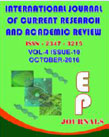Abstract Volume:4 Issue-10 Year-2016 Original Research Articles
 |
Online ISSN : 2347 - 3215 Issues : 12 per year Publisher : Excellent Publishers Email : editorijcret@gmail.com |
The rotifers diversity was carried out for two years (2010-2012) in the Kukkarahally lake of Mysuru. Samples of rotifers were collected from five different localities using plankton net (105 ?m mesh size). Qualitative as well as quantitative analysis was carried out using Shannon diversity index (H'), Evenness index (J) and Species Richness index (S). Totally 15 species of rotifers were identified and documented, out of which 10 species belonged to genus Branchionus, 3 species to genus Keratella and 2 species to genus Filinia. Out of fifteen rotifers recorded during the study period, Brachionus sp. were the most common genera in the lake. The percentage wise composition of Rotifera sps were, B. plicatilis (8%), B. Angularis (4%), B. Rubens (2%), B. Forficula (10%), B. Calyciflorus (2%), B. Falcatus (4%), B. Quadridentatus (1%), B. Caudatus (5%), B. Diversicornis (15%), B.bidentata (2%), K .tropic (16%), K. quadrata(17%), K. cochlearis(13%). Filinia terminalis (2%) and Filinia longiseta (1%). It is noteworthy to record that, the Brachionus forficula showed six significant positive correlation with other rotifers, such as B. plicatilis, B calyciflorus, B. quadridentatus, B. caudatus, K. tropica, and K. quadrata . It is also interesting and noteworthy to record that Brachionus falcatus and Filinia terminalis did not show any correlation with any of the other rotifer sps.
How to cite this article:
Beenamma Joseph and Sadanand M. Yamakanamardi. 2016. Ecology of Rotifer Diversity in the Kukkarahally Lake of Mysuru, Karnataka State of India.Int.J.Curr.Res.Aca.Rev. 4(10): 135-147doi: http://dx.doi.org/10.20546/ijcrar.2016.410.016



Quick Navigation
- Print Article
- Full Text PDF
- How to Cite this Article
- on Google
- on Google Scholor
- Citation Alert By Google Scholar
